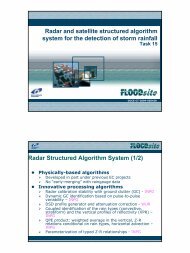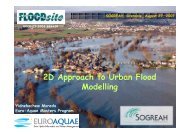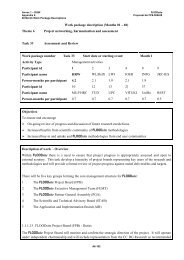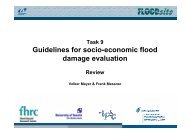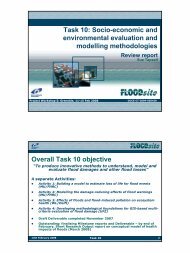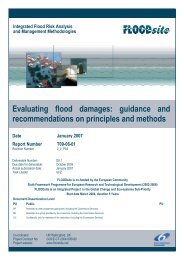Evacuation and traffic management (full report) - FLOODsite
Evacuation and traffic management (full report) - FLOODsite
Evacuation and traffic management (full report) - FLOODsite
You also want an ePaper? Increase the reach of your titles
YUMPU automatically turns print PDFs into web optimized ePapers that Google loves.
Task 17 <strong>Evacuation</strong> D17-1<br />
Contract No:GOCE-CT-2004-505420<br />
1.5 Pilot sites<br />
There were three pilot sites that were utilised in Task 17 as follows:<br />
• The Thames Estuary in the UK;<br />
• The Schelde Estuary in the Netherl<strong>and</strong>s;<br />
• The Gard Region of France.<br />
These are briefly described below. Chapters 5, 6 <strong>and</strong> 7 detail the inundation <strong>and</strong> evacuation modelling<br />
that has been carried out for each of these pilot sites.<br />
1.5.1 Thames Estuary<br />
The Thames Estuary is the large estuary where the River Thames flows into the North Sea. The<br />
estuary is one of the largest inlets on the coast of the UK. Saltmarshes <strong>and</strong> mudflats dominate the<br />
area, although much of the length has man-made embankments where the l<strong>and</strong> behind is now<br />
cultivated or used for grazing. The inner Thames Estuary, now named Thames Gateway, on both<br />
banks of the river, has been designated as one of the principal development areas in Southern Engl<strong>and</strong><br />
by the Office of the Deputy Prime Minister, <strong>and</strong> much development is planned for this area (ABI,<br />
2006). Two specific areas of interest have been researched with regards to evacuation <strong>and</strong> loss of life<br />
modelling. These are the Thamesmead embayment located just downstream of the Thames Barrier<br />
<strong>and</strong> Canvey Isl<strong>and</strong> that is located in the mouth of the estuary. One of the objectives of such an<br />
approach was to identify the usefulness of the output of such models to emergency planners for use in<br />
the planning stage of evacuation planning. This work is discussed in detail in Chapter 5.<br />
1.5.2 Schelde Estuary<br />
The Schelde pilot site is located near the south-western border of the Netherl<strong>and</strong>s <strong>and</strong> Belgium <strong>and</strong><br />
covers the tidally influenced part of the Schelde River. The Dutch part of the river is called<br />
‘Westerschelde’ <strong>and</strong> is a typical estuary with multiple river branches <strong>and</strong> inter-tidal mud flats. The<br />
areas of interest in which evacuation models have been applied within the Schelde pilot are all within<br />
the province of Zeel<strong>and</strong> <strong>and</strong> comprise the following areas:<br />
• Walcheren;<br />
• Zuid-Bevel<strong>and</strong> West;<br />
• Zuid-Bevel<strong>and</strong> East.<br />
Walcheren is piece of l<strong>and</strong> that used to be an isl<strong>and</strong>. However, polders <strong>and</strong> a dam across the Sloe<br />
strait now connected it to the (former) isl<strong>and</strong> of Zuid-Bevel<strong>and</strong>, which in turn has been connected to<br />
the North Brabant mainl<strong>and</strong>. Walcheren lies between the Oosterschelde in the north <strong>and</strong> the<br />
Westerschelde in the south <strong>and</strong> is roughly the shape of a rhombus. Zuid-Bevel<strong>and</strong> is also a piece of<br />
l<strong>and</strong> that used to be an isl<strong>and</strong>. It is now a peninsula, crossed by the Canal through Zuid-Bevel<strong>and</strong> on<br />
the west <strong>and</strong> the Schelde-Rhine Canal to the east. <strong>Evacuation</strong> models have been applied to these areas<br />
to assist emergency planners in Zeel<strong>and</strong> to improving their planning of evacuations. This work is<br />
detailed in Chapter 6.<br />
1.5.3 Gard Region<br />
The Gard River is in southern France. The Gard is 133 km long including its longest tributary<br />
"Gardon de Saint-Jean". It rises in the Cévennes <strong>and</strong> discharges into the Rhône River. In September<br />
2002 <strong>and</strong> again in December 2003, the Gard had record level floods that damaged many of its bridges<br />
including the Pont Saint-Nicolas. In the 2002 floods 24 people were killed <strong>and</strong> the economic damage<br />
was estimated at €1.2 billion. Many of the people that were killed were in cars that were swept away<br />
(Gaume <strong>and</strong> Bouvier, 2004). As part of the work that is being carried out in the Gard Region a<br />
prototype forecasting system to assess when roads will be inundated has been produced. This model<br />
T17_07_02_<strong>Evacuation</strong>_<strong>and</strong>_<strong>traffic</strong>_<strong>management</strong>_D17_1_V4_4_P01.doc 19 03 2008<br />
6




